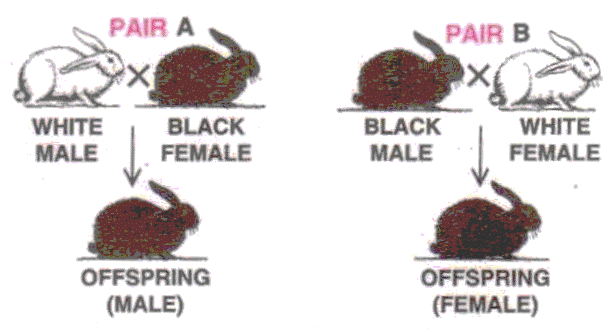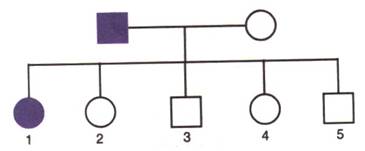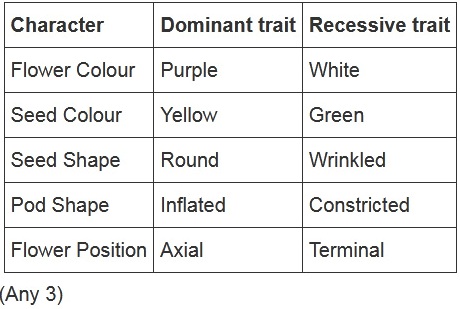Selina Concise Biology Class 10 ICSE Solutions Genetics Some Basic Fundamentals
Selina Concise Biology Class 10 ICSE Solutions Genetics- Some Basic Fundamentals
Exercise 2
A.1.
d) Ascaris
A.2.Which one of the following is the phenotypic monohybrid ratio in F2 generation?
a) 3 : 1
b) 1 : 2 : 1
c) 2 : 2
d) 1 : 3
Solution A.2.
a) 3 : 1
B.1.Match the terms in column I with their the explanations in column II
Column I
(Term) |
Column II
(Explanation) | |
a
| Genetics |
(i) Chromosomes similar in size and shape
|
b
|
Autosomes
|
(ii) The alternative forms of a gene
|
c
|
Recessive gene
|
(iii) Study of laws of inheritance of characters
|
d
|
Allele
|
(iv) A gene that can express when only in a similar pair
|
e
|
Homologous chromosomes
|
(v) Chromosomes other than the pair of sex chromosomes
|
Solution B.1.
(a) – (iii) Study of laws of inheritance of characters
(b) – (v) Chromosomes other than the pair of sex chromosomes
(c) – (iv) A gene that can express when only in a similar pair
(d) – (ii) The alternative forms of a gene
(e) – (i) Chromosomes similar in size and shape
B.2.
Solution B.2.
Lion, tiger, domestic cat (Any two)
B.3.Name any two genetic diseases in humans.
Solution B.3.
Colour-blindness, Thalassaemia, Sickle cell anaemia and Haemophilia (Any two)
B.4.Which one of the following genotypes is homozygous dominant and which one homozygous recessive in regard to tongue rolling:
Rr, rr, RR?
Solution B.4.
Homozygous dominant – RR
Homozygous recessive – rr
C.1.Differentiate between:
(a) Genotype and Phenotype
(b) Character and Trait
(c) monohybrid and dihybrid cross (phenotypic ratio)
Solution C.1.
C.2.Among lion, tiger and domestic cat, all the three have the same number of 38 chromosomes, yet they have different appearances. How do you account for such differences?
Solution C.2.
The characteristics of a species such as physical appearance, body functions and behavior are not only the outcome of chromosome number, but these depend on the genotype of every organism. That means the set of genes present in the organisms may very and therefore lion, tiger and domestic cat have the same number of 38 chromosomes, their characteristics (like different appearances) are the result of the genes located on the chromosomes.
C.3.List any three features of garden pea with their dominant and recessive traits.
Solution C.3.
C.4.Explain why generally only the male child suffers from colour blindness and not the female?
Solution C.4.
- Colour-blindness is caused due to recessive genes which occur on the X chromosome.
- Males have only one X chromosome. If there is recessive gene present on X chromosome, then the male will suffer from colour-blindness.
- Females have two X chromosomes. It is highly impossible that both the X chromosomes carry abnormal gene. Hence, if one gene is abnormal and since it is recessive, its expression will be masked by the normal gene present on the other X chromosome. Females are unlikely to suffer from colour-blindness.
C.5.In a certain species of animals, black fur (B) is dominant over brown fur (b). Show the possible ratio of genotypes and phenotypes of the offspring of pure breeding different coloured parents.
Solution C.5.
Phenotypic Ratio – 3 (Black Fur) :1 (Brown Fur)
Genotypic Ratio – 1(Homozygous Black Fur):2 (Heterozygous Black Fur): 1 (Homozygous Brown Fur)
D.1.Explain the following terms:
(a) Heterozygous
(b) Homozygous
(c) Pedigree chart
Solution D.1.
(a) Heterozygous: The condition in which a pair of homologous chromosomes carries dissimilar alleles for a particular character.
For example –
1. A daughter (XXo) from a normal homozygous mother for colour vision (XX) and a colour blind father has one normal and one defective allele (XoY).
2. Certain tongue rollers are heterozygous with Rr genotype.
(b) Homozygous: The condition in which a pair of homologous chromosomes carries similar alleles for a particular character.
For example –
1. A colorblind daughter (XoXo) will have both the X chromosomes with defective alleles.
2. A non-roller will have rr (homozygous) genotype.
(c) Pedigree Chart: A pedigree chart is a diagram that shows the occurrence and appearance or phenotypes of a particular gene or organism and its ancestors from one generation to the next. In the pedigree chart, males are shown by squares and females by circles.
D.2.State the three Mendel's laws of inheritance.
Solution D.2.
Mendel’s laws of inheritance are:
1. Law of Dominance: Out of a pair of contrasting characters present together, only one is able to express itself while the other remains suppressed. The one that expresses is the dominant character and the one that is unexpressed is the recessive one.
2. Law of Segregation : The two members of a pair of factors separate during the formation of gametes. The gametes combine together by random fusion at the time of zygote formation. This law is also known as ‘law of purity of gametes’.
3. Law of Independent Assortment: When there are two pairs of contrasting characters, the distribution of the members of one pair into the gametes is independent of the distribution of the other pair.
D.3.Does the sex of the child depend on the father or is it just a matter of chance? Discuss.
Solution D.3.
- The sex of the child depends on the father. The egg contains only one X chromosome, but half of the sperms contain X-chromosome whereas the other half contains Y-chromosome. It is simply a matter of chance as to which category of sperm fuses with the ovum and this determines whether the child will be male or female.
- If the egg fuses with X-bearing sperm, the resulting combination is XX and the resulting child is female.
- If the egg fuses with Y-bearing sperm, the resulting combination is XY and the resulting child is male.
E.1.In a certain species of animals, black fur (B) is dominant over brown fur (b). Predict the genotype and phenotype of the offspring, when both parents are 'Bb' or have heterozygous black fur.
E.2.Two pairs (A and B) of rabbits were crossed as given below:

(a) Can you tell which coat colour (black or white) is dominant?
(b) Is the coat colour sex-linked?
Solution E.2.
(a) Black
(b) No
E.3.Make a Punnett square for finding out the proportion of different genotypes in the progeny of a genetic cross between
(a) A pure tall (TT) pea plant with a pure dwarf (tt) pea plant.
(b) Red flower variety of pea (RR) with white flower variety of pea (rr).
Solution E.3.
E.4.A family consists of two parents and their five children and the pedigree chart shown below shows the inheritance of the trait colour blindness in them.

(a) Who is colour blind in the parents - the Father or the Mother?
(b) How many daughters and how many sons have been born in the family?
(c) What does the child 1 indicate about this trait?
(d) On which chromosome is the gene of this trait located?
(e) Name one other trait in humans which follows a similar pattern of inheritance.
Solution E.4.
(a) Father
(b) Two sons and three daughters
(c) The child 1 (daughter) is colour blind
(d) X chromosome
(e) Haemophilia
Selina Concise Biology Class 10 ICSE Solutions Chapter 2 - Genetics Some Basic Fundamentals | Selina Concise Biology Class 10 ICSE Solutions Genetics Some Basic Fundamentals





